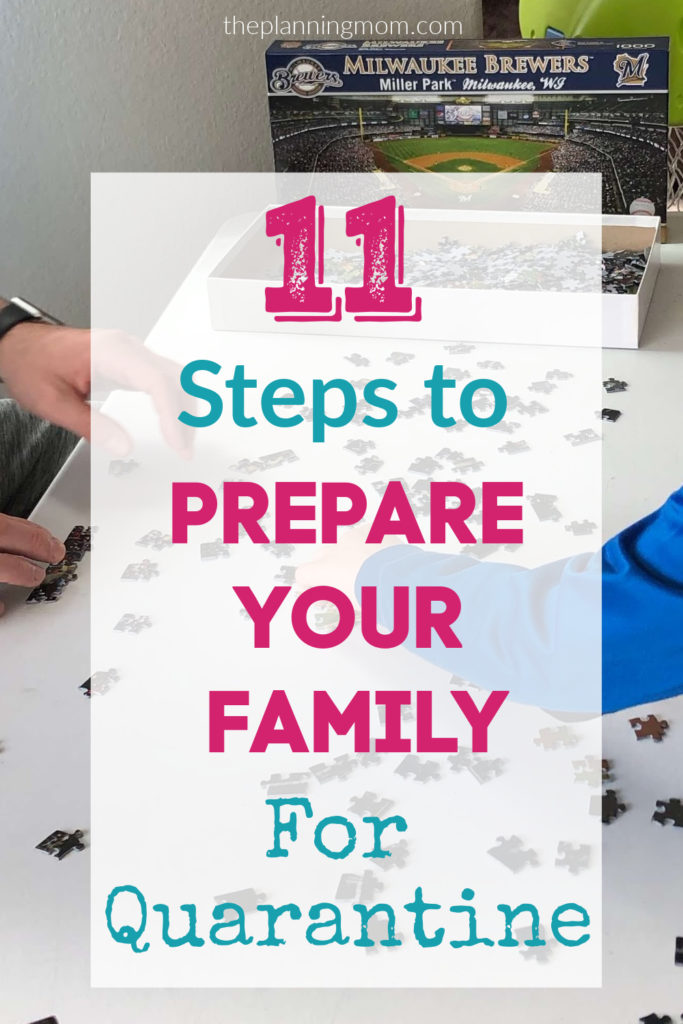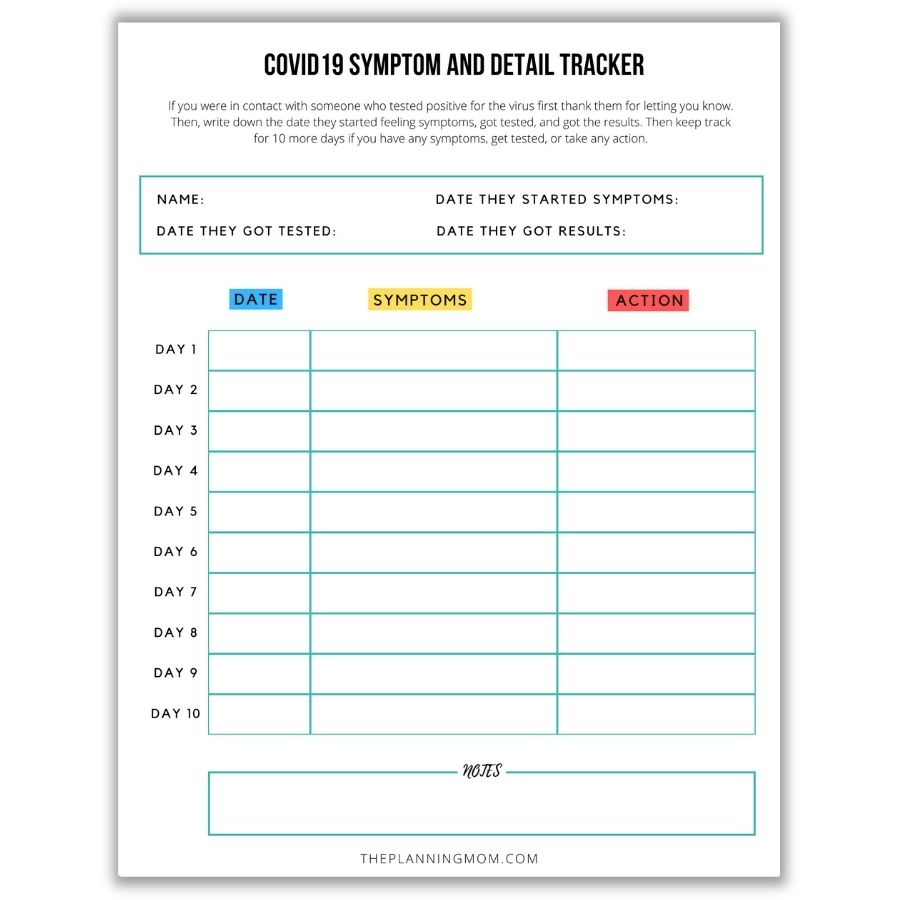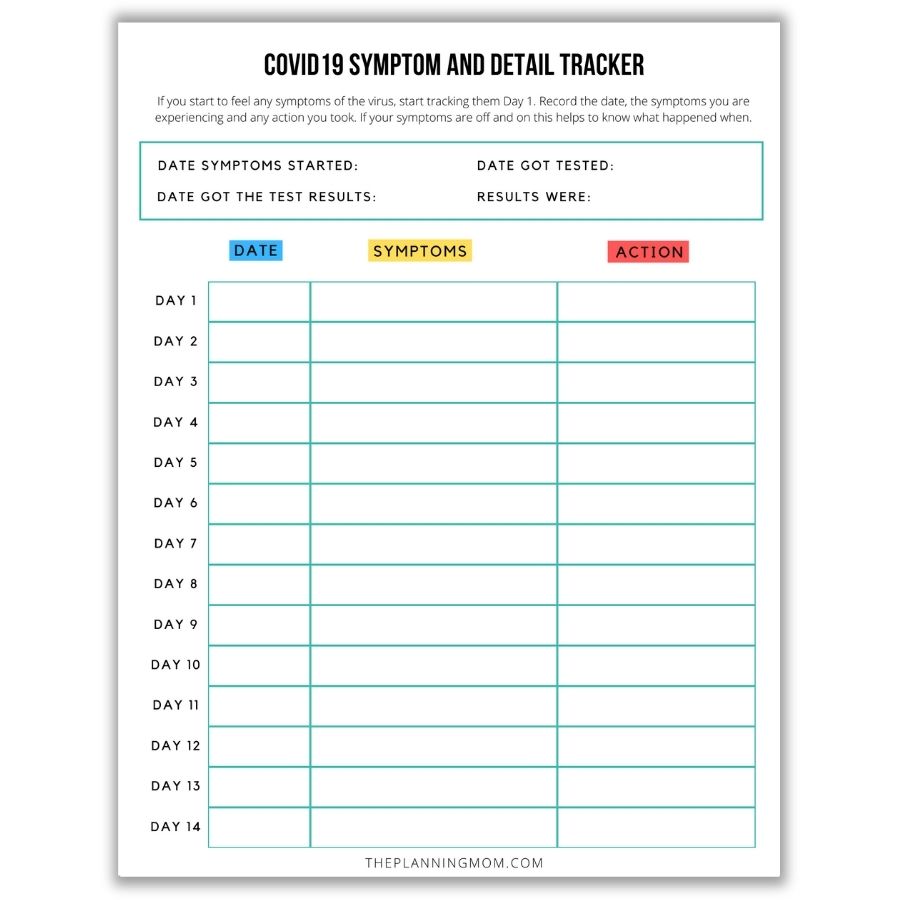Are you and your family members prepared to be quarantined for 14 days? If the pandemic directly affects your family or someone in your household gets Covid-19, do you know what to do, where to go, and who to contact? Ease your mind and decrease potential stress by making a quarantine plan. Prepare your family ahead for a quarantine with these easy steps below.

11 Steps to Get Your Family Ready to Quarantine
With the pandemic numbers rising, now is the time to prepare for a quarantine or if a family member gets Covid-19. Take a few minutes to look things up, write things out, think through situations, and have a conversation with your family.
In addition, continue to take precautions to stay healthy and safe. This includes washing your hands frequently and disinfecting your home. Follow these 11 steps to get a quarantine plan ready for your family.
1. Know School Quarantine Protocol
In the event your child needs to quarantine from school, know the school’s protocol for the different scenarios. The number of days a child may be out of school or in virtual school could be different depending on who they came into contact with or who got the virus. For example, the number of days may be different if they came into contact with someone who has the virus, they get the virus, or live with someone who got the virus.
Most schools worked with their local health department to have a comprehensive Covid-19 plan. This likely includes the following: a specific Covid-19 protocol, what they are doing to keep kids and staff safe, what you as a family need to do to stay safe, and what you need to do if you come into contact with the virus.
If you have the information from the school read it, print it out and highlight important parts. Take notes on the parts where it describes what you need to do if your child needs to quarantine.
2. Make a Plan for Virtual School
If your child’s school makes a decision to go all virtual, or if your child has to quarantine and go virtual for several weeks, make a plan how this will work. Check on the following:
- Check with the school on their plans and expectations for virtual children. Know what you will have to do and when. For example, do you have to sign in online at a certain time or is there a virtual schedule?
- Do you know what to do to get started? Who to contact?
- Who do you contact if you have questions, concerns or issues? Which staff member will you be dealing with while virtually learning?
- Do you have to pick up worksheets or other materials from school if you are virtual?
- Discuss who at home is going to help out with virtual learning, teach lessons if needed, check work.
- Are you equipped technology wise to do virtual learning from home? Will the school provide a chromebook or tablet for your child to use?
- How does online learning take place? Through an app? Website? Do a trial run of logging in to make sure all is in order.
3. Prepare a Childcare Plan for Young Children
If you have young children who cannot stay home alone or watch themselves, prepare a plan who is going to watch them if they have to quarantine from school or daycare. The following questions can prompt your planning responses:
- Can adults who live in the home work from home?
- Is there another family member or friend in your bubble that feels comfortable watching them?
- Will the adults in the household have to take off of work?
- If there are multiple adults in the household can they take turns taking off or working from home to watch the kids?
In addition, if it is a case that the daycare needs to shut down due to lack of staff check if they have another option or place where your kids can go until they open back up.
4. Know Your Employer’s Quarantine Protocol and Rules
Check with your employer on their quarantine and Covid-19 protocol and rules. First, find out if you can work from home in the event you need to quarantine, your young children need to quarantine, or you get Covid-19. If possible, check how working from home works and get prepared to do so.
In addition, ask if working from home affects pay or vacation. Do you need to take vacation or unpaid days when you are at home? Does your employer have quarantine pay? If they have quarantine pay, how many days do they pay? If your employer does not have specific Covid-19 protocols, ask your human resources department or representative.
5. Get Ready to Take Notes
In order to prepare your family for the pandemic, do some research, answer questions, and take notes. Quarantine may come on quickly and immediately. You may get a call or text that you were exposed to Covid-19 and need to begin quarantine right away. There may not be time to prepare or figure things out. So think through things in advance, write things down, and have a plan.
Quarantine will likely start in one of two ways. Either you or a family member will have been exposed to someone who has the virus or you will feel symptoms on your own that could be from the virus. In either scenario, it is important to track details and record notes each day.
Exposed to Someone With the Virus
If you were in contact with someone who tested positive for the virus first thank them for letting you know. Sometimes people are not communicating with others they were around the virus or contact tracing when they have symptoms or test positive.

Next, write down the day the individual started feeling symptoms, the day they got tested, and the day they got the results. Then keep track for 10 more days if you have any symptoms.
Personal Covid19 Symptoms
If you start to feel any symptoms of the virus, start recording details that day. Write down the date, the symptoms you are experiencing, and any action you took. If your symptoms are off and on this helps to know what happened when. In the event you go to the doctor or get tested, they will ask you when you started experiencing symptoms and what they are so tracking them as they happen will help.

Furthermore, it is only human for days to blend together. With everything else going on it is difficult to remember details from 3, 5, or 7 days ago. So taking notes is super helpful so you know what happened when.
Covid19 Symptom and Detail Tracker
To help track symptoms and information, I prepared these worksheets above for my family and I. This way we can have all the details on one document, and organized by day to share with others or to help us make decisions on what to do next. You can grab these FREE worksheets in my planning printables library HERE or right below. Print the worksheet out and take notes or keep track of notes online by digitally editing the printable.
6. Have a Plan to Contract Trace
In the event you or a family member get the virus, contract trace your last 5 days. Think through who you were with and where you went. Try to figure out where and when you could have gotten the virus. This will help with your communication process and to notify others you were around.
Then, if anyone was with you there let them know you tested positive and that they may have gotten it from there as well. Furthermore, if you were in close contact with anyone since where you potentially got the virus or with anyone the past 5 days be sure to communicate with them that you tested positive. Then they can stay safe and keep others safe by quarantining.
7. Create a Quarantine Communication List
Another step to preparing your family for a quarantine is to get a communication list ready. If you would have to quarantine, have a list of the people you need to contact even if they were not with you. This list is for the people your quarantine and unavailability may affect. This may include but is not limited to the following people:
- Your employer and human resources
- Your child’s school and/or daycare
- Any activities you are involved with on a weekly or biweekly basis that you may be missing
- Any events you will be missing
- Let those who live with you know and anyone else you see appropriate
- Anyone you were by or with the past 5 days
8. Keep a Schedule of Upcoming Events
Keeping a calendar or schedule of upcoming events not only helps you stay organized and on top of things, but in this situation it will help you know what you are missing during quarantine. Furthermore, it will help you know who to contact to postpone events or notify that you are unable to come. It will assure you don’t forget anyone or to cancel anything.

9. Stock Up on Essentials
Get your family and house ready to quarantine by stocking up on basic essentials. You should have a supply of essential items to last you 2 weeks – long enough to quarantine. These essentials should include but are not limited to the following:
- Non perishable food
- Medications
- Toiletries (shampoo and soap)
- Paper products (toilet paper)
- Laundry supplies
For more details on stockpiling and the best items to stockpile click HERE.
10. Find Out Your State, County, and City Protocols and Regulations
Look up your state and county protocols regarding quarantine and if you have been in contact with someone who has Covid-19. Check on the recommendations if you would have symptoms of the virus and what you should do.
Furthermore, keep up to date where you can go and what you can do during the pandemic. Certain businesses and stores may be closed or have limited days and hours they are open. Know the rules and regulations for where you live as each city, county, and state can be different.
11. Know Where to Get Tested
Lastly, research in advance Covid-19 testing locations in your city and county. In the event you need to get tested, you want to know where to go.
Likely there are several different options in your area. Some testing sites may be free. While others you will have to pay and some may cost more than others. Certain sites need insurance information and may accept insurance while others will not.
Next, some testing sites may get faster results than others. Typically, the free testing sites take longer to get results than the ones where you pay. For example, a free testing site may get results in 3-4 days while a paid site results may be ready within 24 hours.
Some testing sites require an appointment while others are walk up or drive thru. Certain sites require a doctors order to get tested. This means you have to first see your doctor before you can get tested. If your doctor thinks you should get tested then he/she prescribes a test. Otherwise they may tell you to watch your symptoms and call if anything gets worse. This protocol may be in place if you live in an area with low testing supplies. Also, if a doctor is ordering a test, the results tend to come faster.
Stay up to date with testing locations and protocols in your area as these may change depending on demand. In the end, know where you need to go to get tested. Know the process, who to contact, and where you need to go.
Final Thoughts to Prepare Your Family for a Quarantine
The pandemic can be frightening especially with all the unknowns. Many ill symptoms are related to the virus. It seems if you have almost any symptom you may wonder if you have Covid-19 and what you should do. Plan in advance for the virus and the unknowns it brings by following these steps to get you and your family ready.
Leave a Reply